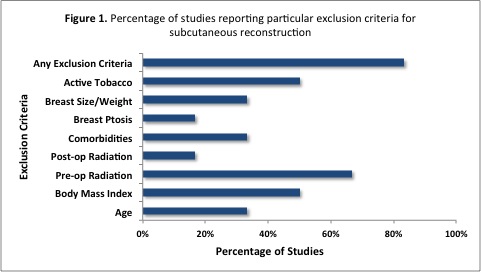|
|
|
|
|
Back to 2016 Annual Meeting
Subcutaneous alloplastic breast reconstruction with acellular dermal matrix or mesh: a systematic review
Ara A. Salibian, MD, Jordan D. Frey, MD, Mihye Choi, MD, Nolan S. Karp, MD.
New York University, New York, NY, USA.
BACKGROUND: The availability of acellular dermal matrix (ADM) and synthetic mesh products has prompted plastic surgeons to revisit subcutaneous implant-based breast reconstruction. The literature is limited, however, with regards to indications and complication rates. The purpose of this systematic review is to better understand the available evidence for the utility of subcutaneous alloplastic breast reconstruction with ADM or mesh with regards to patient selection, techniques and outcomes.
METHODS: A systematic review of the Medline and Cochrane databases was performed for original studies reporting breast reconstruction with ADM or mesh, and subcutaneous implant placement. Reviews, revision cases and non-English articles were excluded. Studies were analyzed for level of evidence, inclusion and exclusion criteria for subcutaneous reconstruction, reconstruction characteristics and complications. Data was compiled for studies reporting these metrics.
RESULTS: Seven studies were identified for review after application of inclusion and exclusion criteria (Table 1). The majority of studies (71.4%) were Level IV evidence case series. 85.7% of studies had particular contraindications for subcutaneous reconstructions (Figure 1) with the majority of authors excluding patients with pre-operative radiation, and half of studies excluding patients based on body mass index and active smoking. When determining appropriateness for subcutaneous reconstruction, only 50% of studies commenting on patient selection assessed mastectomy flap perfusion. 45.2% of reconstructions were direct-to-implant, 33.3% two-stage, and 21.5% single-stage adjustable implant, with ADM utilized in 76.9% of reconstructions versus mesh. Follow-up time ranged from 1 to 55 months when cited. Pooled complication rates included: major infection 1.6% (95% Confidence Interval [CI] 0.2-3.0), seroma 2.6% (CI 0.8-4.4), full nipple-areola complex (NAC) necrosis 0.3% (CI 0.0-0.9), partial NAC necrosis 2.3% (CI 0.1-4.6), major flap necrosis 1.3% (CI 0.0-2.6), wound healing complication 2.0% (CI 0.4-3.6), explantation 3.3% (CI 1.3-5.3) and Baker Grade III or IV capsular contracture 1.2% (CI 0.0-2.8) (Table 2).
CONCLUSIONS: Subcutaneous alloplastic breast reconstruction with ADM or mesh has low short-term complication rates in small case series with limited follow-up and highly selective patient populations. Larger comparative studies, as well as better-defined selection criteria and outcomes reporting are needed to develop appropriate indications and algorithms for offering patients subcutaneous implant-based reconstructive options.
Table 1. Summary of Included Studies| Authors | Year | Study Design | Patients/Breasts | ADM/Mesh | Mastectomy | Stage | Follow-up (mo) | | Berna et al. | 2014 | CS | 17/23 | ADM | SSM, NSM | Single: DTI | 14 (mean) | | Reitsamer et al. | 2015 | CS | 13/22 | ADM | NSM | Single: DTI | 6 (median) | | Woo et al. | 2015 | CS | 79/135 | ADM | SSM, NSM | Single: DTI, Two-stage | -- | | Becker et al. | 2015 | CS | 31/62 | ADM, Mesh | SSM, NSM | Single: AI | 24 (mean) | | Bernini et al. | 2015 | NRCT | 34/39 | Mesh | SSM, NSM | Single: DTI | 25 (median) | | Casella et al. | 2015 | CS | 25/25 | Mesh | SSM, NSM | Two-stage | 14 (median) | | Zhu et al. | 2016 | RCS | --/15 | ADM | SSM, NSM | Two-stage | 17 (mean) | | CS, Case series; NRCT, Non-randomized controlled trial; RCS, Retrospective cohort study; ADM, Acellular dermal matrix; NSM, Nipple-sparing mastectomy; SSM, Skin-sparing mastectomy; DTI, Direct-to-implant; AI, Adjustable implant | Table 2. Pooled Complication Rates| Complication | Rate (%) | 95% CI** | | Major Infection* | 1.6 | 0.2-3.0 | | Seroma | 2.6 | 0.8-4.4 | | Full NAC Necrosis | 0.3 | 0.0-0.9 | | Partial NAC Necrosis | 2.3 | 0.1-4.6 | | Major Flap Necrosis | 1.3 | 0.0-2.6 | | Wound Healing | 2.0 | 0.4-3.6 | | Explantation | 3.3 | 1.3-5.3 | | CC: Grade III/IV | 1.2 | 0.0-2.8 | | NAC, Nipple-areolar complex; CC, Capsular contracture; CI, Confidence interval *Major infection: infection requiring return to operating room; **n=306 with exception of partial NAC necrosis and capsular contracture rate (n=171) | 
Back to 2016 Annual Meeting
|
|
